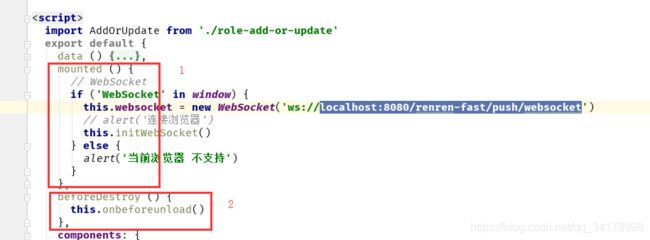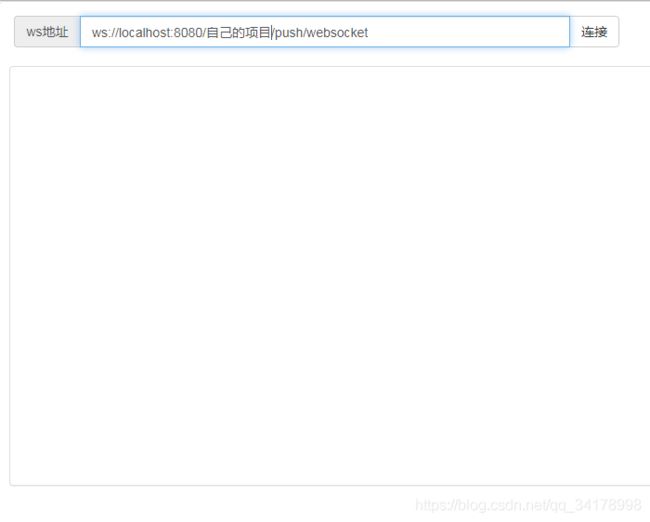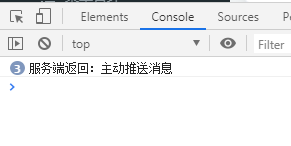SpringBoot+webSocket+Vue设置后台向前端推送消息
应用场景介绍:
在页面的数据需要实时刷新的时候,或者在页面需要接收后台的消息时候,如果采用前端轮询会造成资源占用较大,并且数据刷新也是不及时的,比如当我后台在监听MQ的消息时候,当从MQ监听到消息后我需要将MQ消息推送到前端实时展示,这时候就需要用到webSocket了。
1.首先搭建一个SpringBoot的项目,这里我就不重复了,然后引入jar包
<!-- WebSocket --> <dependency> <groupId>org.springframework.boot</groupId> <artifactId>spring-boot-starter-websocket</artifactId> <version>2.1.0.RELEASE</version> </dependency>
2、编写websocketConfig配置类
import org.springframework.context.annotation.Bean;import org.springframework.context.annotation.Configuration;import org.springframework.web.socket.server.standard.ServerEndpointExporter; /** * @Author dingchengxiang * @Description //TODO WebSocket配置类 * @Date 15:53 2019/11/11 * @Param * @return **/@Configurationpublic class WebSocketConfig { @Bean public ServerEndpointExporter serverEndpointExporter(){ return new ServerEndpointExporter(); } }
3.websocket的实现类
import lombok.extern.slf4j.Slf4j;import org.springframework.stereotype.Component;import javax.websocket.*;import javax.websocket.server.PathParam;import javax.websocket.server.ServerEndpoint;import java.io.IOException;import java.util.concurrent.CopyOnWriteArraySet; @Component@ServerEndpoint("/push/websocket")@Slf4jpublic class WebSocketServer { //静态变量,用来记录当前在线连接数。应该把它设计成线程安全的。 private static int onlineCount = 0; //concurrent包的线程安全Set,用来存放每个客户端对应的MyWebSocket对象。 private static CopyOnWriteArraySet webSocketSet = new CopyOnWriteArraySet(); //与某个客户端的连接会话,需要通过它来给客户端发送数据 private Session session; //接收sid private String sid=""; /** * 连接建立成功调用的方法*/ @OnOpen public void onOpen(Session session,@PathParam("sid") String sid) { this.session = session; webSocketSet.add(this); //加入set中 addOnlineCount(); //在线数加1 log.info("有新窗口开始监听:"+sid+",当前在线人数为" + getOnlineCount()); this.sid=sid; /*try { sendMessage(JSON.toJSONString(RestResponse.success())); } catch (IOException e) { log.error("websocket IO异常"); }*/ } /** * 连接关闭调用的方法 */ @OnClose public void onClose() { webSocketSet.remove(this); //从set中删除 subOnlineCount(); //在线数减1 log.info("有一连接关闭!当前在线人数为" + getOnlineCount()); } /** * 收到客户端消息后调用的方法 * * @param message 客户端发送过来的消息*/ @OnMessage public void onMessage(String message, Session session) { //log.info("收到来自窗口"+sid+"的信息:"+message); if("heart".equals(message)){ try { sendMessage("heartOk"); } catch (IOException e) { e.printStackTrace(); } } } /** * * @param session * @param error */ @OnError public void onError(Session session, Throwable error) { log.error("发生错误"); error.printStackTrace(); } /** * 实现服务器主动推送 */ public void sendMessage(String message) throws IOException { this.session.getBasicRemote().sendText(message); } /** * 群发自定义消息 * */ public static void sendInfo(String message) throws IOException { for (WebSocketServer item : webSocketSet) { try { //这里可以设定只推送给这个sid的,为null则全部推送// if(sid==null) { item.sendMessage(message); log.info("推送消息到窗口"+item.sid+",推送内容:"+message);// }else if(item.sid.equals(sid)){// item.sendMessage(message);// } } catch (IOException e) { continue; } } } public static synchronized int getOnlineCount() { return onlineCount; } public static synchronized void addOnlineCount() { WebSocketServer.onlineCount++; } public static synchronized void subOnlineCount() { WebSocketServer.onlineCount--; } }
4、新增一个控制层接口作为测试接口能够调用的
/** * @Author dingchengxiang * @Description //TODO 测试websocket发送消息 * @Date 14:41 2019/11/12 * @Param [] * @return java.lang.String **/ @PostMapping("/sendAllWebSocket") public String test() { String text="你们好!这是websocket群体发送!"; try { webSocketServer.sendInfo(text); }catch (IOException e){ e.printStackTrace(); } return text; }
此处需要注意一下,后台可能与拦截需要将接口放开,本人是在shiroConfig中进行设置
5、编写前端vue的代码
先在这两处添加,
mounted () { // WebSocket if ('WebSocket' in window) { this.websocket = new WebSocket('ws://localhost:8080/自己的项目地址/push/websocket') // alert('连接浏览器') this.initWebSocket() } else { alert('当前浏览器 不支持') } }, beforeDestroy () { this.onbeforeunload() },
然后在方法中编写具体实现
methods: { initWebSocket () { // 连接错误 this.websocket.onerror = this.setErrorMessage // 连接成功 this.websocket.onopen = this.setOnopenMessage // 收到消息的回调 this.websocket.onmessage = this.setOnmessageMessage // 连接关闭的回调 this.websocket.onclose = this.setOncloseMessage // 监听窗口关闭事件,当窗口关闭时,主动去关闭websocket连接,防止连接还没断开就关闭窗口,server端会抛异常。 window.onbeforeunload = this.onbeforeunload }, setErrorMessage () { console.log('WebSocket连接发生错误 状态码:' + this.websocket.readyState) }, setOnopenMessage () { console.log('WebSocket连接成功 状态码:' + this.websocket.readyState) }, setOnmessageMessage (event) { // 根据服务器推送的消息做自己的业务处理 console.log('服务端返回:' + event.data) }, setOncloseMessage () { console.log('WebSocket连接关闭 状态码:' + this.websocket.readyState) }, onbeforeunload () { this.closeWebSocket() }, closeWebSocket () { this.websocket.close() }}
这个时候启动我们就可以看到效果了,页面控制台打印的值
后台控制台打印的值
到这一步基本的就已经实现了,但是我们现在要加入中间件MQ监听到消息后进行消息返回,那么还需要下面几步,
6、MQ我在这个demo中没有集成,我就用一个定时任务来模拟MQ监听到消息以后的处理步骤。
新建一个Task类
/** * @Author dingchengxiang * @Description //TODO 消息定时器,通知websocket * @Date 14:56 2019/11/12 * @Param * @return **/@Componentpublic class Task { @Autowired private WebSocketServer webSocketServer; /** * @throws Exception */ @Scheduled(cron="0/5 * * * * ? ") public void JqcaseSearch() { try { System.out.println("这是心跳"); webSocketServer.sendInfo("主动推送消息"); } catch (Exception e) { e.printStackTrace(); } }}
这么设置,每隔五秒,就会模拟MQ监听到一条消息,然后调用WebSocket服务的发送消息,此时我们需要在启动类上面加一个定时器注解
@SpringBootApplication@EnableSchedulingpublic class Application { public static void main(String[] args) { SpringApplication.run(RenrenApplication.class, args); } }
加上@EnableScheduling注解后定时器才会有效果
这时候我们再编写个简单的html页面来帮助我们观察
DOCTYPE html><html lang="en"><head> <meta charset="utf-8"> <meta http-equiv="X-UA-Compatible" content="IE=edge"> <meta name="viewport" content="width=device-width,initial-scale=1.0"> <link rel="stylesheet" href="https://cdn.jsdelivr.net/npm/[email protected]/dist/css/bootstrap.min.css" integrity="sha384-BVYiiSIFeK1dGmJRAkycuHAHRg32OmUcww7on3RYdg4Va+PmSTsz/K68vbdEjh4u" crossorigin="anonymous"> <title>websocket测试页面title>head><body><div class="panel panel-default"> <div class="panel-body"> <div class="row"> <div class="col-md-6"> <div class="input-group"> <span class="input-group-addon">ws地址span> <input type="text" id="address" class="form-control" placeholder="ws地址" aria-describedby="basic-addon1" value="ws://localhost:8080/自己的项目/push/websocket"> <div class="input-group-btn"> <button class="btn btn-default" type="submit" id="connect">连接button> div> div> div> div> <div class="row" style="margin-top: 10px;display: none;" id="msg-panel"> <div class="col-md-6"> <div class="input-group"> <span class="input-group-addon">消息span> <input type="text" id="msg" class="form-control" placeholder="消息内容" aria-describedby="basic-addon1"> <div class="input-group-btn"> <button class="btn btn-default" type="submit" id="send">发送button> div> div> div> div> <div class="row" style="margin-top: 10px; padding: 10px;"> <div class="panel panel-default"> <div class="panel-body" id="log" style="height: 450px;overflow-y: auto;"> div> div> div> div>div> <script src="https://cdn.jsdelivr.net/npm/[email protected]/dist/jquery.min.js">script><script src="https://cdn.jsdelivr.net/npm/[email protected]/dist/js/bootstrap.min.js" integrity="sha384-Tc5IQib027qvyjSMfHjOMaLkfuWVxZxUPnCJA7l2mCWNIpG9mGCD8wGNIcPD7Txa" crossorigin="anonymous">script> <script type="text/javascript"> $(function () { var _socket; $("#connect").click(function () { _socket = new _websocket($("#address").val()); _socket.init(); }); $("#send").click(function () { var _msg = $("#msg").val(); output("发送消息:" + _msg); _socket.client.send(_msg); }); }); function output(e) { var _text = $("#log").html(); $("#log").html(_text + "
" + e); } function _websocket(address) { this.address = address; this.client; this.init = function () { if (!window.WebSocket) { this.websocket = null; return; } var _this = this; var _client = new window.WebSocket(_this.address); _client.onopen = function () { output("websocket打开"); $("#msg-panel").show(); }; _client.onclose = function () { _this.client = null; output("websocket关闭"); $("#msg-panel").hide(); }; _client.onmessage = function (evt) { output(evt.data); }; _this.client = _client; }; return this; }script>body>html>
这时候启动SpringBoot,再运行html,
此时连接后我们会发现,后台会一直向页面推送消息
同时在VUE的控制台也会发现
有消息产生,到此demo就结束了,我们可以利用返回的消息做数据刷新,做消息推送等。
2019年11月13日补充:
需要对列表进行推送刷新的话,有两种将数据推送的方式
1、修改发送的消息为Object类型
/** * 实现服务器主动推送 */ public void sendMessage(Object message) throws Exception { this.session.getBasicRemote().sendObject(message); }
但是修改之后发现会报错
提示我没有编码类。
之后查阅一下,发现需要编码类,比较麻烦,就没有才用了
2、采用json字符串的方式发送到前端,FastJsonUtils是我自己编写的json工具类
public void JqcaseSearch() { Map<String, Object> params = new HashMap<>(); params.put("t","1573630630476"); params.put("page","1"); params.put("limit","10"); PageUtils page = sysRoleService.queryPage(params); JSONObject jsonObject = FastJsonUtils.toJsonObject(R.ok().put("page", page)); try { webSocketServer.sendData(jsonObject); } catch (Exception e) { e.printStackTrace(); } }
再编写调用类
/** * 自定义刷新数据 * */ public static void sendData(JSONObject object) throws Exception { for (WebSocketServer item : webSocketSet) { try { item.sendMessage(object.toJSONString()); log.info("推送消息到窗口,推送内容:"+object); } catch (IOException e) { continue; } }
再调用主动推送的方法
/** * 实现服务器主动推送 */ public void sendMessage(String message) throws Exception { /* this.session.getBasicRemote().sendObject(message);*/ this.session.getBasicRemote().sendText(message); }
最后到页面将字符串转化为jsondata
最后再根据自己的实际页面将jsondata里的数据放到到页面上去







